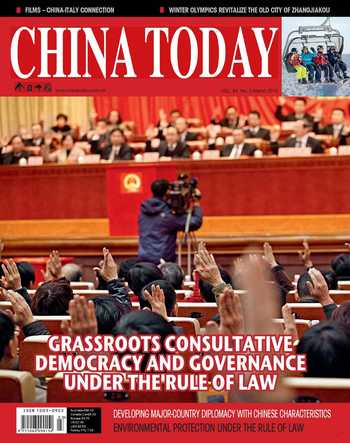China’s Economy in a Global Context
By ZHANG LIJUAN
THE National Bureau of Statis- tics has released key figures on the Chinese economy in 2014. As expected, Chinas growth rate as measured by GDP was 7.4 percent, the lowest since 2002. Over the past 15 years, Chinas average annual GDP growth was 8.9 percent. The size of the Chinese economy has thus increased nearly eight fold from RMB 8.94 trillion (US $1.43 trillion) in 2000 to RMB 63.64 trillion (US$10.18 trillion) in 2014. China has created a true economic miracle.
The slowing of Chinas economic growth is nothing new. Rather, a gradual slowdown is part of the plan, as Premier Li Keqiang said at the World Economic Forum in Davos, convened in January. Chinas GDP growth rate began single-digit expansion in 2011. For years, scholars and researchers all over the world have had serious discussions about how sustainable Chinas economy is and how far it may go before a hard landing. Premier Li reassured us that China will not experience a hard landing, although the dangers in the Chinese economy have been well recognized, risks in the real estate and financial sectors chief among them. Expanding local government debt and the emerging shadow banking industry have also sparked dire warnings from critics. Such risks still exist, and, if anything, have worsened. To deal with these dangers, the Chinese government has prepared to accept the next stage of Chinas economic development— the“new normal,” which basically means accepting slower growth within a better growth structure and consumptiondriven economy.
Today, it is very difficult to judge the Chinese economy based solely on domestic factors. This is because the Chinese economy exists and operates in a wider, or “new global context.” This is a new experience for China. The world economic scenario has changed dramatically since the 1990s, and the current economic climate is not even similar to that of the 2000s. New challenges and conflicts are borderless but connected in a global value chain. A misstep in one nations economy can quickly spread to that of another to potentially end an era of economic integration and global growth.
The worlds leading economies have to face the following common challenges and conflicts in a new global context: the conflict between national interests and global governance, the conflict between domestic political interests and economic logic, the conflict between regional and multilateral free trade approaches, and the conflict between domestic economic growth and global climate change.
These challenges are new and complicated. The years of emerging economies flourishing seem to be over, and there is no single country that can solve such issues independently. Unilateralism is not going to solve global conflicts. The world needs a new development strategy with vision. Every trading nation has to face the constantly changing circumstances that are increasingly more complicated, inherently difficult and interrelated in a global context. Reshaping 21st century trade policies is particularly challenging for top trading nations like China and the United States. As we can all see from Asian regional economic cooperation, a sound de facto U.S.-China bilateral diplomatic relationship is not only critical to a new Asian regional trade regime, but also to dynamic world economic prosperity.
China has to face new trends in the world economy too: The U.S. is attracting more foreign direct investment than China; manufacturing labor costs in India and the Philippine are now lower than they are in China; climate change and sustainable development have become the most pressing challenges facing humanity; regionalism is playing a more aggressive role in global trade and geopolitics; and collapsing oil prices are making the world economy vulnerable. According to Christine Lagarde, managing director of the International Monetary Fund, the global economy is entering an era of “new mediocre”growth.
Inside China, economic challenges are ongoing and ever-changing. As stated by Ma Jiantang, head of the National Bureau of Statistics, the country is undertaking a problem-solving urbanization project involving 300 million people: 100 million people who have already moved to cities and who expect new policies to support their urbanization; 100 million who are waiting to immigrate from the countryside of Northwest China to larger cities; and another 100 million who live in villages under the jurisdiction of cities waiting for further policies that will make them better off. The issue of dealing with the urbanization of 300 million people remains a huge challenge for the Chinese leadership. Furthermore, China has also transformed its economy from an agricultural to an industrial, and then to a consumer economy in just one generation. Needless to say, a “new normal” Chinese economy has to deal with both domestic and global complexity and uncertainty.
The combination of Chinas “new normal” with Lagardes “new mediocre”global economic growth has significant implications for both China and the world. The rebalancing and restructuring of Chinas economy towards a “new normal” will prove very helpful in sustaining the global economy.

